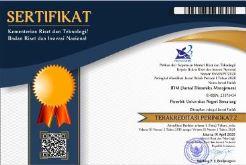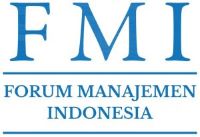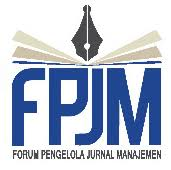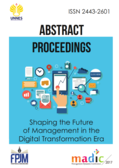Business and Leisure “Bleisure†in Organization: Antecedents and Outcomes
Abstract
The purpose of this study is to explore the concept of bleisure (business and leisure) in an organization along with its antecedents and outcomes. Bleisure is a combination of completing work and entertainment or a pleasant situation at the same time. The sample used in this study were 106 respondents who work in Event Organizer (EO). Data collection methods in this study used questionnaires. Data was analyzed by using regression test. The results of this study indicate that if people work in an organization that combines business and leisure (bleisure), they will have the creativity and high innovation performance, and the application of business and leisure (bleisure) can be achieved through mobile working style and gamification. Bleisure or a combination of fun activities and work can enhance creative intelligence and innovation performance for individuals in completing work, every person will be more creative and innovative. Leisure and work are related things, when individuals are burdened with assignments, the application of leisure in an organization is one of the effective things.
Keywords
Full Text:
PDFReferences
Ajibua M, A. (2012) Involvement of Academic and NonAcademic Staff in Physical Leisure Activities in Tertiary Institutions in Ondo State. Unpublished Master Thesis. Department of Physical and Health Education, Obafemi Awolowo University, Ile-Ife, Osun State, Nigeria, 1-30.
Akinboye, J. O. (2002). Creativity and Innovation in Business. Nigerian Journal of Applied Psychology, 7(1), 1-41.
Alstott, A. L. (1999). Work vs Freedom: a Liberal Challenge to Employment Subsidies a Liberal Challenge to Employment Subsidies. The Yale Law Journal, 108(5), 967-1058.
Arora, P. (2011). Online Social Sites as Virtual Parks: an Investigation into Leisure Online and Offline. The Information Society, 27(2), 113-120.
Axtell, C., Hislop, D., & Whittaker, S. (2008). Mobile Technologies in Mobile Spaces: Findings from the Context of Train Travel. International Journal of Human-Computer Studies, 66(12), 902-915.
Baud-Bovy, M. (2002). Tourism and Recreation Handbook of Planning and Design. Oxford: Architectural Press.
Beaton, A. A., Funk, D. C., & Funk, D. C. (2008). Leisure Sciences: an Interdisciplinary an Evaluation of Theoretical Frameworks for Studying Physically Active Leisure an Evaluation of Theoretical Frameworks for Studying Physically Active Leisure. Leisure Sciences: an Interdisciplinary Journal, 30(1), 37-41.
Berkery, E., Morley, M. J., Tiernan, S., Purtill, H., & Parry, E. (2017). On the Uptake of Flexible Working Arrangements and the Association with Human Resource and Organizational Performance Outcomes. European Management Review, 14(2), 165-183.
Blackshaw, T (2017). Decentring Leisure: Rethinking Leisure Theory (Book Review). Annals of Leisure Research, 20(2), 240-242.
Blohm, I., & Leimester, J. M. (2013). Gamification Design of IT-Based Enhancing Services for Motivational Support and Behavioral Change. Business and Information Systems Engineering, 5(4), 275-278.
Bosworth, A. (2012). Keas : Developing a Successful Game-Based Employee Wellness Program. Games for Health Journal, 1(3), 189-191.
Broadhurst, R. (2008). Managing environments for leisure and recreation. NY: Routledge
Carr, A. E., & Tang, L.-P. (2005). Sabbaticals and Employee Motivation: Benefits, Concerns and Implications. Journal of Education for Business, 80(3),160-164.
Chevron, J., & Primeau, M. (1996). The Telecommuting Innovation Opportunity. Journal of Consumer Marketing, 51(2), 74-80.
Dahlin, K., Taylor, M., & Fichman, M. (2004). Today’s Edisons or Weekend Hobbyists: Technical Merit and Success of Inventions by Independent Inventors. Research Policy, 33(8), 1167-1183.
Davidson, D. (2008). Beyond Fun: Serious Games and Media. Pittsburgh, PA: ETC Press.
De Jong, J., Von Hippel, E.A., Flowers, S. (2010). Comparing Business and Household Sector Innovation in Consumer Products: Findings from a Representative Study in the UK. Management Science, 58(9), 1669-1681.
Deterding, S., & Dixon, D. (2011). From Game Design Elements to Gamefulness: Defining “Gamification.†Proceedings. The 15th International Academic MindTrek Conference, 9-15.
Deterding, S., Khaled, R., Nacke, L. E., & Dixon, D. (2011). Gamification: Toward a Definition. CHI 2011 Gamiï¬Cation Workshop. Proceedings, Vancouver, BC, Canada, 12-15.
Dumazedier, J. (2001). Lazer e Cultura Popular. São Paulo: Perspectiva.
Florida, R. (2012). The Rise of the Creative Class-Revisited: 10th anniversary edition. New York: Basic Books.
Ford, R. C., John W. Newstrom, and Frank S. McLaughlin. 2004. Making Workplace Fun More Functional. Industrial and Commercial Training , 36(3), 117-20.
Gino, F., & Ariely, D. (2012). The Dark Side of Creativity: Original Thinkers Can be More Dishonest. Journal of Personality and Social Psychology, 102(3), 445-459.
Goffin, K., & Mitchell, R. (2005). Innovation Management: Strategy and implementation using the pentathlon framework. 2nd Edition. NY: Palgrave MacMillan.
Grant, A. M., Berg, J. M., & Cable, D. M. (2014). Job Titles as Identity Badges: How Self-Reflective Titles Can Reduce Emotional Exhaustion. Academy of Management Journal, 57(4), 1201-1225.
Grewal, R. (2000). The Role of the Social-Identity Function of Attitudes in Consumer Innovativeness and Opinion Leadership. Journal of Economic Psychology, 21(3), 233-252.
Hamari, J., & Koivisto, J. (2015). International Journal of Information Management Why do People Use Gamification Services?. International Journal of Information Management, 35(4), 419-431.
Harju, L., Hakanen, J. J., & Schaufeli, W. B. (2014). Job Boredom and its Correlates in 87 Finnish Organizations. Journal of Occupational and Environmental Medicine, 56(9), 911-918.
Hislop, D. And Axtell, C., (2007), To Infinity and Beyond?: Workspace and the Multi-Location Worker. New Technology, Work and Employment, 24(1), 60-75.
Humphreys, P., Mcadam, R., & Leckey, J. (2005). Longitudinal Evaluation of Innovation Implementation in SMEs. European Journal of Innovation Management, 8(3), 283-304.
Huotari, K. (2012). Defining Gamification a Service Marketing Perspective. Proceedings. The 16th International Academic MindTrek Conference, 17-22.
Jackson, P., Gharavi, H., Klobas, J., Jackson, P., & Gharavi, H. (2009). Technologies of the Self : Virtual Work and the Inner Panopticon. Information Technology & People, 15(3), 219-243.
Janssen, O. (2000). Job Demands, Perceptions of Effort-Reward Fairness and Innovative Work Behaviour. Journal of Occupational and Organizational Psychology, 73(3), 287-302.
Jeppesen, L. B., & Lakhani, K. R. (2010). Marginality and Problem-Solving Effectiveness in Broadcast Search. Organization Science, 21(5), 1-18.
Kakihara, M. (2004). Practising Mobile Professional Work: Tales of Locational, Operational, and Interactional Mobility. The Journal of Policy, Regulation and Strategy for Telecommunication, Information and Media, (6)3, 180-187.
Kapp, K. M. (2012). The Gamification of Learning and Instruction: Game-Based Methods and Strategies for Training and Education. San Francisco, CA: Pfeiffer (Wiley).
Karl, K. (2005). Attitudes toward Workplace Fun: a Three Sector Comparison. Journal of Leadership & Organizational Studies, 12(2), 1-17.
Kleiber, D. A., Walker, G., & Mannell, R. C. (2011). a Social Psychology of Leisure (2nd ed.). State College: Venture Publishing, Inc.
Kotro, T. (2007). User Orientation through Experience: a Study of Hobbyist Knowing in Product. Human Technology, 3(2), 154-166.
Laguna, M., & Marklund, J. (2005). Business Process Modeling, Simulation, and Design. Upper Saddle River: Pearson Prentice Hall.
Lakhani, K. R., & Wolf, R. G. (2003). Why Hackers Do What They Do: Understanding Motivation and Effort in Free/Open Source Software Projects. MIT Sloan Working Paper, 4425-03. https://ssrn.com/abstract=443040 or http://dx.doi.org/10.2139/ssrn.443040 .
Lee, J., & Hammer, J. (2011). Gamification in Education: What, How, Why Bother?. Gamification in Education: What, How, Why Bother?. Academic Exchange Quarterly, 15(2), 1-5.
Madjar, N., Oldham, G. R., & Pratt, M. G. (2002). There’s no Place Like Home?. the Contributions of Work and Nonwork Creativity Support to Employees Creative Performance. Academy of Management Journal, 45(4), 757-768.
Manoux, S. A., Richards, M., & Marmot, M. (2003). Leisure Activities and Cognitive Function in Middle Age: Journal of Epidemiology and Community Health, 57(11), 907-913.
Martins, L. L., Gilson, L. L., Maynard, M. T., & Gilson, L. L. (2004). Journal of Management, 30(6), 805-835.
McGonigal, J. (2011). Reality is Broken: Why Games Make Us Better and How They Can Change the World. NY: The Penguin Press.
Medaille, A. (2010). The Power of Play : Fostering Creativity and Innovation in Libraries. Journal of Library Innovation, 1(October), 8-23.
Mollick, E. R., & Rothbard, N. (2014). Mandatory Fun: Consent, Gamification and the Impact of Games at Work. The Wharton School Research Paper Series. Philadelphia, PA: University of Pennsylvania.
Muntean, C. I. (2011). Raising Engagement in E-Learning through Gamification. Proceedings. The 6th International Conference on Virtual Learning ICVL 2011, (1), 323-329.
Palmer D, Lunceford S, Patton AJ (2012) The Engagement Economy: How Gamification is Reshaping Businesses. Deloitte Review, 11, 52-69.
Pigram, J. J., Jenkins, J. M. (2006). Outdoor Recreation Management. NY: Routledge.
Pine, J., & Gilmore, J. H. (2011). The Experience Economy: Past, Present and Future. Handbook on the Experience Economy.
Pryor, M .G., Singleton, L.P., Taneja, S., & Humphreys, J. H. (2010), Workplace Fun and its Correlates: a Conceptual Inquiry, International Journal of Management, (27)2, 294-302.
Rahi, S. (2017). Research Design and Methods: a Systematic Review of Research Paradigms, Sampling Issues and Instruments Development International Journal of Economics. International Journal of Economics & Management Sciences, 6(2), 1-5.
Ravenscroft, N., Gilchrist, P., Ravenscroft, N., & Gilchrist, P. (2009). The Emergent Working Society of Leisure. Journal of Leisure Research, 41(1), 22-39.
Santrock, J. W. (2008). A Topical Approach to Lifespan Development. NY: McGraw-Hill Companies, Inc.
Serrat, O. (2009). Harnessing Creativity and Innovation in the. Asian Development Bank, 61(September), 1-11.
Siha, S. M., & Monroe, R. W. (2006). Telecommuting’s Past and Future: Telecommuting’s. A Literature Review and Research Agenda, 12(4), 455-482.
Spreitzer, G. M., Cameron, L., & Garrett, L. (2017). Alternative Work Arrangements: Two Images of the New World of Work. Annual Review of Organizational Psychology and Organizational Behavior, 4(1), 473-499.
Teodoro, R., Ozturk, P., Naaman, M., Mason, W., Lindqvist, J., Tech, C., & York, N. (2014). The Motivations and Experiences of the On-Demand Mobile Workforce. Performing Crowd Work, 236-247.
Tews, M. J., Michel, J. W., & Bartlett, A. (2012). The Fundamental Role of Workplace Fun in Applicant Attraction. Journal of Leadership & Organizational Studies, 19(1), 105-114.
Torrance, E. P., Ph, D., Torrance, E. P., Fitzgerald, K., & Batson, A. (2000). The Rationale and Validation of the Torrance Tests of Creative Thinking, Verbal and Figural. Tempo, 20(2), 1-35.
Tremblay, D. (2002). Balancing Work and Family with Telework? Organizational Issues and Challenges for Women and Managers. Women in Management Review, 17(3/4), 157-170.
Uglanova, E., & Dettmers, J. (2018). Sustained Effects of Flexible Working Time Arrangements on Subjective Well-Being. Journal of Happiness Studies, 19(6), 1727-1748.
Watson, I., & Lightfoot, D. J. (2003). Mobile working with Connexions. Facilities, 21(13), 347-352.
West, M.A. (2004). Effective Teamwork: Practical Lessons from Organizational Research. Oxford: Blackwell Publishing.
Zichermann, G., & Cunningham, C. (2011). Gamification by Design: Implementing Game Mechanics in Web and Mobile Apps. Cambridge, MA: O’Reilly Media
Zimmerer, T., & Scarborough, N. (2008). Essentials of Entrepreneurship and Small Business Management. NJ: Prentice-Hall.
View Counter: Abstract - 1513 and PDF - 1019
Refbacks
- There are currently no refbacks.





